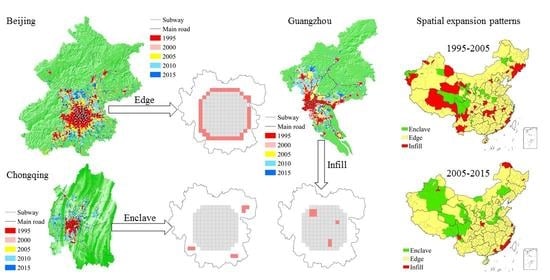Analysis of Spatial and Temporal Changes and Expansion Patterns in Mainland Chinese Urban Land between 1995 and 2015
Abstract
1. Introduction
2. Materials and Methods
2.1. Study Area
2.2. Data Sources
2.3. Methods
2.3.1. Methods for Quantifying Urban Land Spatial Expansion
2.3.2. Methods for Calculating Land Sources for Urbanization
2.3.3. Methods for Calculating Urban Land Use Spatial Expansion
3. Results
3.1. Spatial and Temporal Characteristics of Urban Land Use Expansion in Mainland China
3.2. Analysis of Land Sources for Urbanization
3.3. Urban Land Use Spatial Expansion Patterns
3.4. Urban Land Expansion in Major Urban Agglomerations in China
3.5. Urban Land Spatial Expansion Patterns for Major Cities in China
4. Discussion
5. Conclusions
Author Contributions
Funding
Informed Consent Statement
Data Availability Statement
Conflicts of Interest
References
- Seto, K.C.; Giineralp, B.; Hutyra, L.R. Global forecasts of urban expansion to 2030 and direct impacts on biodiversity and carbon pools. Proc. Natl. Acad. Sci. USA 2012, 109, 16083–16088. [Google Scholar] [CrossRef] [PubMed]
- Wang, S.; Fang, C.; Sun, L.; Su, Y.; Chen, X.; Zhou, C.; Feng, K.; Hubacek, K. Decarbonizing China’s Urban Agglomerations. Ann. Am. Assoc. Geogr. 2019, 109, 266–285. [Google Scholar] [CrossRef]
- Wu, R.; Li, Z.; Wang, S. The varying driving forces of urban land expansion in China: Insights from a spatial-temporal analysis. Sci. Total Environ. 2021, 766, 142591. [Google Scholar] [CrossRef] [PubMed]
- Yang, J.; Guo, A.; Li, Y.; Zhang, Y.; Li, X. Simulation of landscape spatial layout evolution in rural-urban fringe areas: A case study of Ganjingzi District. Giscience Remote Sens. 2019, 56, 388–405. [Google Scholar] [CrossRef]
- Yang, J.; Yang, R.; Chen, M.-H.; Su, C.-H.; Zhi, Y.; Xi, J. Effects of rural revitalization on rural tourism. J. Hosp. Tour. Manag. 2021, 47, 35–45. [Google Scholar] [CrossRef]
- Homer, C.; Dewitz, J.; Jin, S.; Xian, G.; Costello, C.; Danielson, P.; Gass, L.; Funk, M.; Wickham, J.; Stehman, S.; et al. Conterminous United States land cover change patterns 2001–2016 from the 2016 National Land Cover Database. ISPRS J. Photogramm. Remote Sens. 2020, 162, 184–199. [Google Scholar] [CrossRef]
- Zhu, X.; Zhang, P.; Wei, Y.; Li, Y.; Zhao, H. Measuring the efficiency and driving factors of urban land use based on the DEA method and the PLS-SEM model—A case study of 35 large and medium-sized cities in China. Sustain. Cities Soc. 2019, 50, 101646. [Google Scholar] [CrossRef]
- Yang, J.; Luo, X.; Jin, C.; Xiao, X.; Xia, J. Spatiotemporal patterns of vegetation phenology along the urban–rural gradient in Coastal Dalian, China. Urban For. Urban Green. 2020, 54, 126784. [Google Scholar] [CrossRef]
- Li, S.; Bing, Z.; Jin, G. Spatially Explicit Mapping of Soil Conservation Service in Monetary Units Due to Land Use/Cover Change for the Three Gorges Reservoir Area, China. Remote Sens. 2019, 11, 468. [Google Scholar] [CrossRef]
- Wang, K.; Yin, H. The Impact of Urbanization and Land Intensive Use on Environmental Pollution A Case Study on 35 Cities in China. In Proceedings of the 2017 4th International Conference on Industrial Economics System and Industrial Security Engineering (IEIS), Kyoto, Japan, 24–27 June 2017. [Google Scholar]
- Yang, J.; Ren, J.; Sun, D.; Xiao, X.; Xia, J.; Jin, C.; Li, X. Understanding land surface temperature impact factors based on local climate zones. Sustain. Cities Soc. 2021, 69, 102818. [Google Scholar] [CrossRef]
- Lyu, R.; Clarke, K.C.; Zhang, J.; Jia, X.; Feng, J.; Li, J. The impact of urbanization and climate change on ecosystem services: A case study of the city belt along the Yellow River in Ningxia, China. Comput. Environ. Urban Syst. 2019, 77, 101351. [Google Scholar] [CrossRef]
- Qiao, Z.; Wu, C.; Zhao, D.; Xu, X.; Yang, J.; Feng, L.; Sun, Z.; Liu, L. Determining the Boundary and Probability of Surface Urban Heat Island Footprint Based on a Logistic Model. Remote Sens. 2019, 11, 1368. [Google Scholar] [CrossRef]
- Souza, C.M.; Shimbo, Z.; Rosa, J.; Parente, M.R.; Alencar, L.L.A.; Rudorff, B.F.T.; Hasenack, H.; Matsumoto, M.; Ferreira, G.L.; Souza-Filho, P.W.M.; et al. Reconstructing Three Decades of Land Use and Land Cover Changes in Brazilian Biomes with Landsat Archive and Earth Engine. Remote Sens. 2020, 12, 2735. [Google Scholar] [CrossRef]
- Khan, T.U.; Mannan, A.; Hacker, C.E.; Ahmad, S.; Amir Siddique, M.; Khan, B.U.; Din, E.U.; Chen, M.; Zhang, C.; Nizami, M.; et al. Use of GIS and Remote Sensing Data to Understand the Impacts of Land Use/Land Cover Changes (LULCC) on Snow Leopard (Panthera uncia) Habitat in Pakistan. Sustainability 2021, 13, 3590. [Google Scholar] [CrossRef]
- Labib, S.M.; Lindley, S.; Huck, J.J. Spatial dimensions of the influence of urban green-blue spaces on human health: A systematic review. Environ. Res. 2020, 180, 108869. [Google Scholar] [CrossRef]
- Gao, Y.; Kii, M.; Nonomura, A. Urban research—Urban systems; new findings on urban systems described by investigators at Kagawa University (urban expansion using remote-sensing data and a Monocentric Urban Model). Ecol. Environ. Conserv. 2019, 77, 567–585. [Google Scholar]
- Simwanda, M.; Murayama, Y.; Phiri, D.; Nyirenda, V.R.; Ranagalage, M. Simulating Scenarios of Future Intra-Urban Land-Use Expansion Based on the Neural Network-Markov Model: A Case Study of Lusaka, Zambia. Remote Sens. 2021, 13, 942. [Google Scholar] [CrossRef]
- Zhao, M.; Cai, H.; Qiao, Z.; Xu, X. Influence of urban expansion on the urban heat island effect in Shanghai. Int. J. Geogr. Inf. Sci. 2016, 30, 2421–2441. [Google Scholar] [CrossRef]
- Estoque, R.C.; Murayama, Y. Intensity and spatial pattern of urban land changes in the megacities of Southeast Asia. Land Use Policy 2015, 48, 213–222. [Google Scholar] [CrossRef]
- Li, X.; Yang, L.; Ren, Y.; Li, H.; Wang, Z. Impacts of Urban Sprawl on Soil Resources in the Changchun–Jilin Economic Zone, China, 2000–2015. Int. J. Environ. Res. Public Health 2018, 15, 1186. [Google Scholar] [CrossRef]
- Xu, X.; Min, X. Quantifying spatiotemporal patterns of urban expansion in China using remote sensing data. Cities 2013, 35, 104–113. [Google Scholar] [CrossRef]
- Xu, Q.; Yang, R.; Dong, Y.-X.; Liu, Y.-X.; Qiu, L.-R. The influence of rapid urbanization and land use changes on terrestrial carbon sources/sinks in Guangzhou, China. Ecol. Indic. 2016, 70, 304–316. [Google Scholar] [CrossRef]
- Kuang, W. Simulating dynamic urban expansion at regional scale in Beijing-Tianjin-Tangshan Metropolitan Area. J. Geogr. Sci. 2011, 21, 317. [Google Scholar] [CrossRef]
- Wang, H.; Zhang, B.; Liu, Y.; Liu, Y.; Xu, S.; Deng, Y.; Zhao, Y.; Chen, Y.; Hong, S. Multi-dimensional analysis of urban expansion patterns and their driving forces based on the center of gravity-GTWR model: A case study of the Beijing-Tianjin-Hebei urban agglomeration. Acta Geogr. Sin. 2018, 73, 1076–1092. [Google Scholar]
- Matos, C.; Petrovan, S.O.; Wheeler, P.M.; Ward, A.I. Landscape connectivity and spatial prioritization in an urbanising world: A network analysis approach for a threatened amphibian. Biol. Conserv. 2019, 237, 238–247. [Google Scholar] [CrossRef]
- Wilson, E.H.; Hurd, J.D.; Civco, D.L.; Prisloe, M.P.; Arnold, C. Development of a geospatial model to quantify, describe and map urban growth. Remote Sens. Environ. 2003, 86, 275–285. [Google Scholar] [CrossRef]
- Liu, J.; Shao, Q.; Yan, X.; Fan, J.; Zhan, J.; Deng, X.; Kuang, W.; Huang, L. The climatic impacts of land use and land cover change compared among countries. J. Geogr. Sci. 2016, 26, 889–903. [Google Scholar] [CrossRef]
- Liu, X.-B.; Li, X.; Chen, Y.-M.; Qin, Y.; Li, S.; Chen, M. Landscape Expansion Index and Its Applications to Quantitative Analysis of Urban Expansion. Acta Geogr. Sin. 2009, 64, 1430–1438. [Google Scholar] [CrossRef]
- Xu, G.; Zhou, Z.; Jiao, L.; Zhao, R. Compact Urban Form and Expansion Pattern Slow Down the Decline in Urban Densities: A Global Perspective. Land Use Policy 2020, 94, 104563. [Google Scholar] [CrossRef]
- Encarnação, S.; Gaudiano, M.; Santos, F.C.; Tenedório, J.A.; Pacheco, J.M. Fractal cartography of urban areas. Sci. Rep. 2012, 2, 527. [Google Scholar] [CrossRef]
- Encarnação, S.; Gaudiano, M.; Santos, F.C.; Tenedório, J.A.; Pacheco, J.M. Urban Dynamics, Fractals and Generalized Entropy. Entropy 2013, 15, 2679–2697. [Google Scholar] [CrossRef]
- Liu, J.; Kuang, W.; Zhang, Z.; Xu, X.; Qin, Y.; Ning, J.; Zhou, W.; Zhang, S.; Li, R.; Yan, C.; et al. Spatiotemporal characteristics, patterns, and causes of land-use changes in China since the late 1980s. J. Geogr. Sci. 2014, 24, 195–210. [Google Scholar] [CrossRef]
- Liu, J.; Liu, M.; Zhuang, D.; Zhang, Z.; Deng, X. Study on spatial pattern of land-use change in China during 1995–2000. Sci. China Ser. D Earth Sci. 2003, 46, 373–384. [Google Scholar] [CrossRef]
- Liu, J.; Zhang, Z.; Xu, X.; Kuang, W.; Zhou, W.; Zhang, S.; Li, R.; Yan, C.; Yu, D.; Wu, S.; et al. Spatial patterns and driving forces of land use change in China during the early 21st century. J. Geogr. Sci. 2010, 20, 483–484. [Google Scholar] [CrossRef]
- Xu, M.; He, C.; Liu, Z.; Dou, Y.; Satish, U. How Did Urban Land Expand in China between 1992 and 2015? A Multi-Scale Landscape Analysis. PLoS ONE 2016, 11, e0154839. [Google Scholar] [CrossRef]
- Song, X.; Chang, K.T.; Yang, L.; Scheffran, J. Change in Environmental Benefits of Urban Land Use and Its Drivers in Chinese Cities, 2000–2010. Int. J. Environ. Res. Public Health 2016, 13, 535. [Google Scholar] [CrossRef]
- Shi, Y.; Sun, X.; Zhu, X.; Li, Y.; Mei, L. Characterizing growth types and analyzing growth density distribution in response to urban growth patterns in peri-urban areas of Lianyungang City. Landsc. Urban Plan. 2012, 105, 425–433. [Google Scholar] [CrossRef]
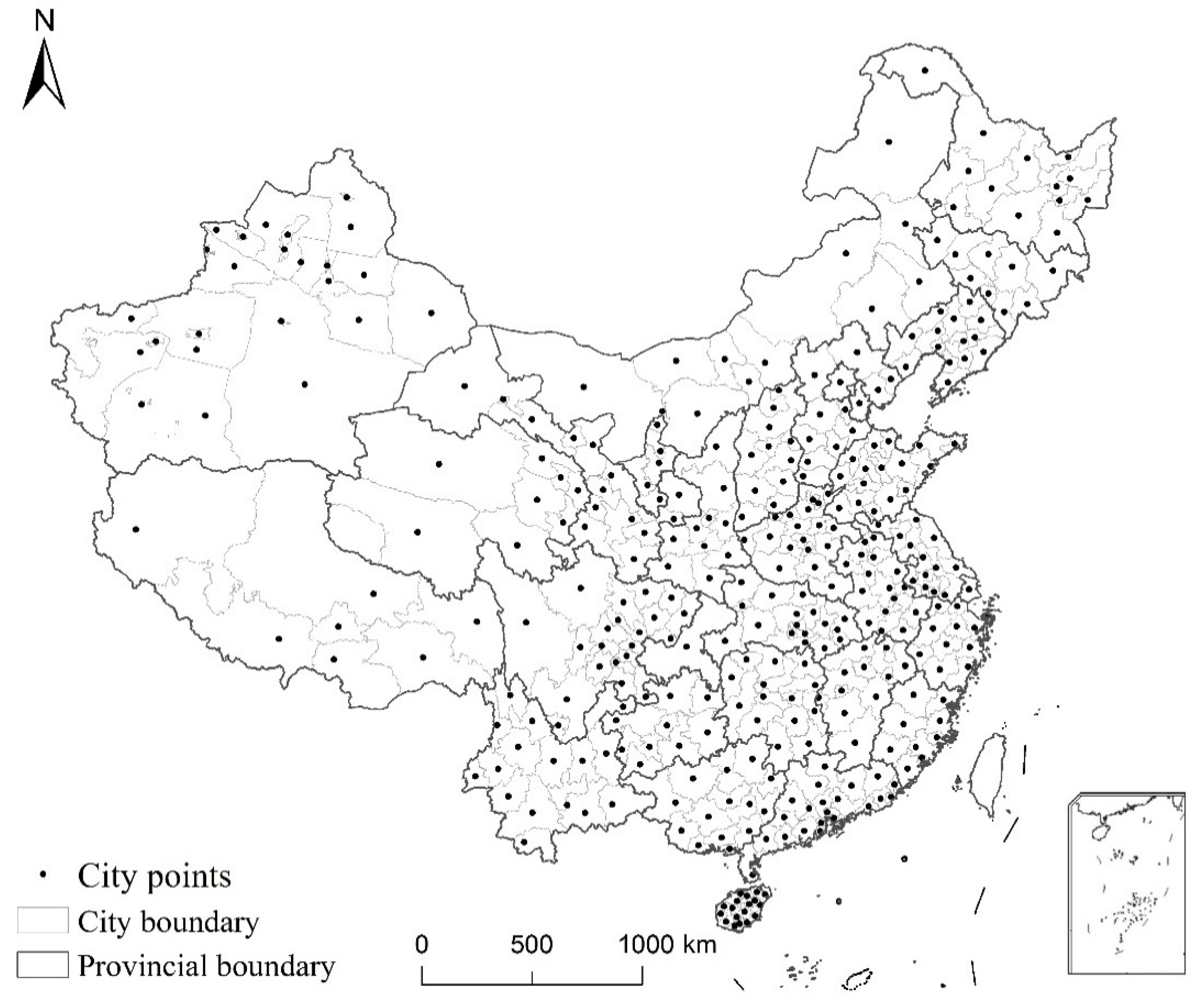
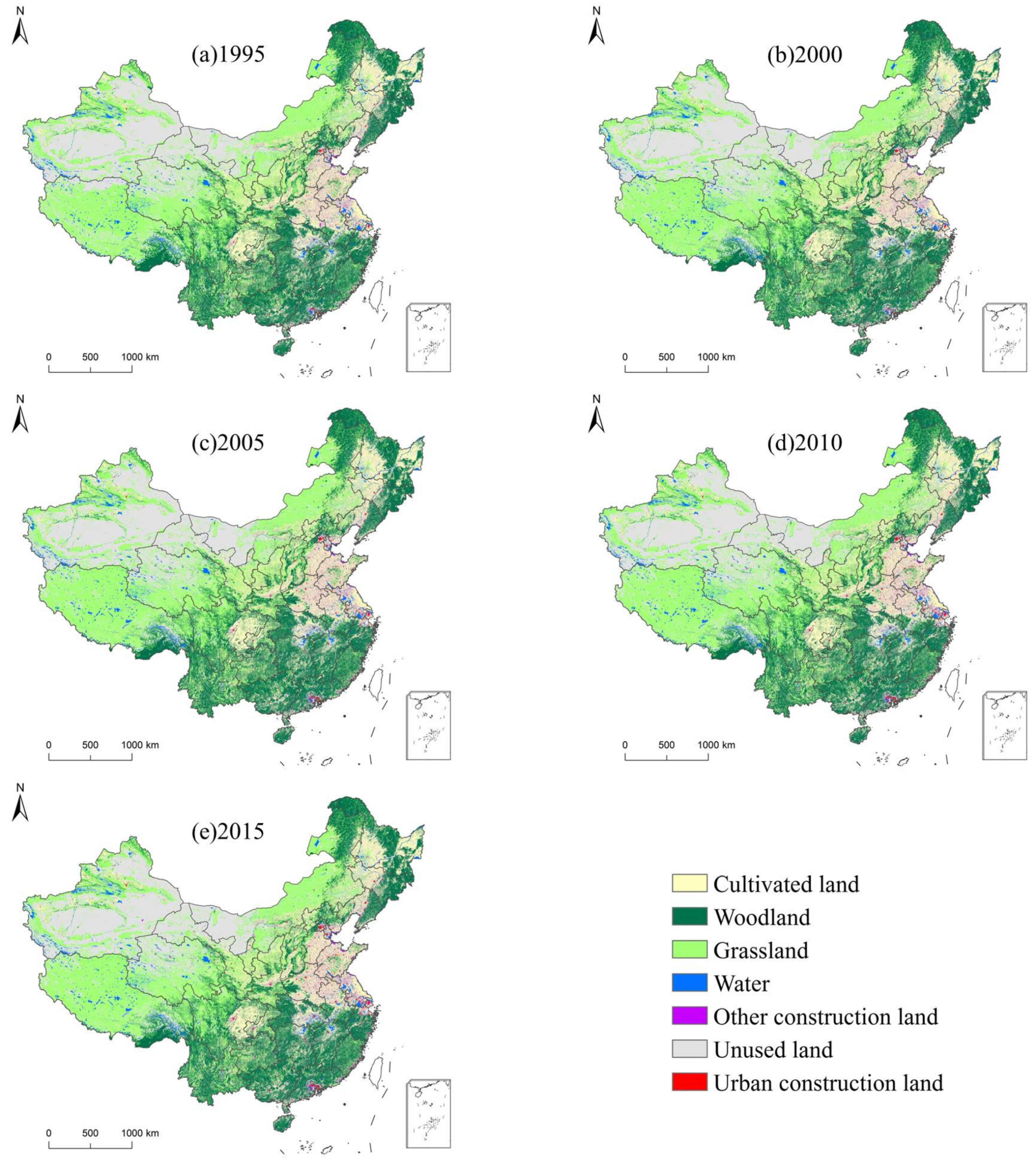

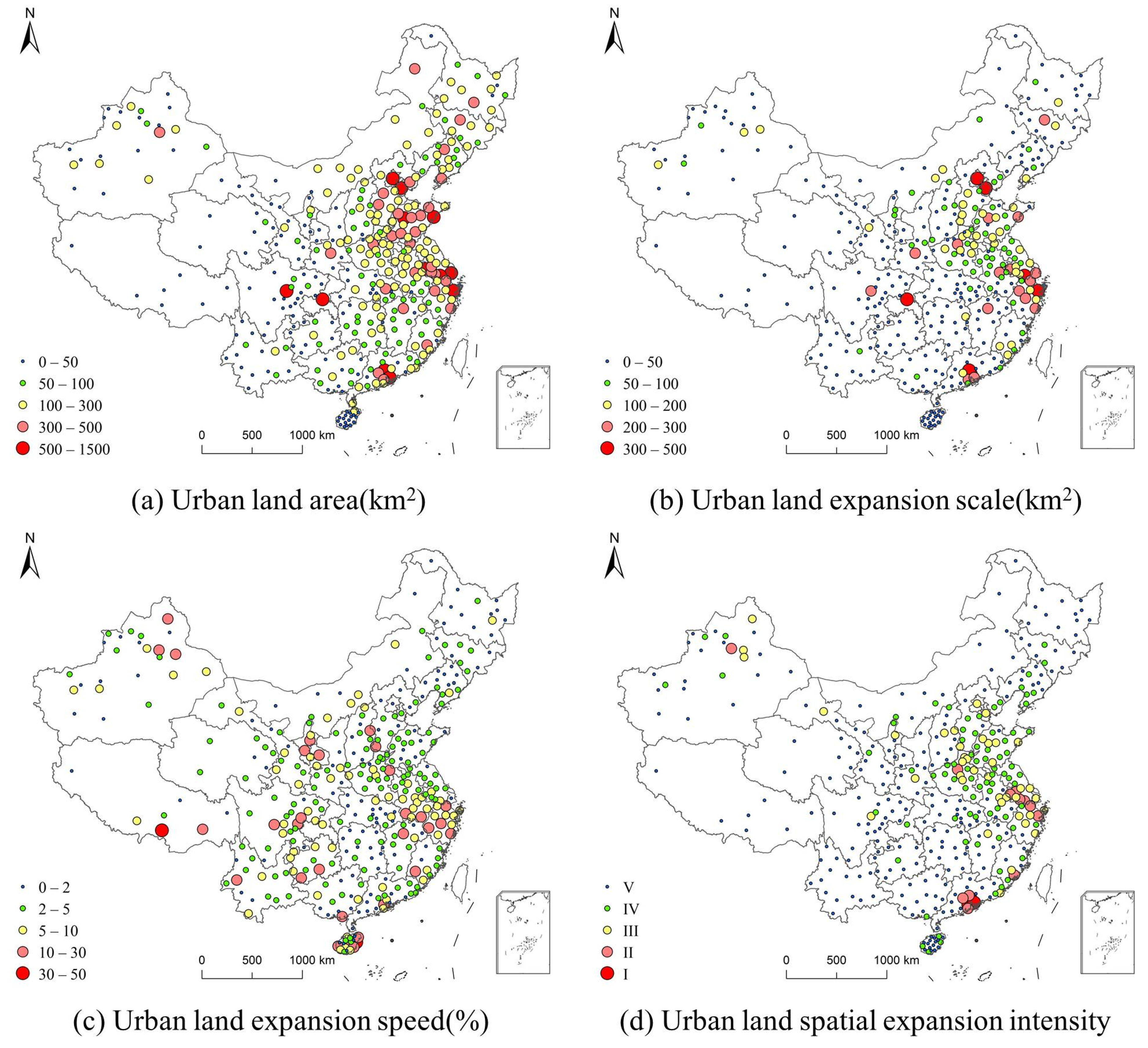
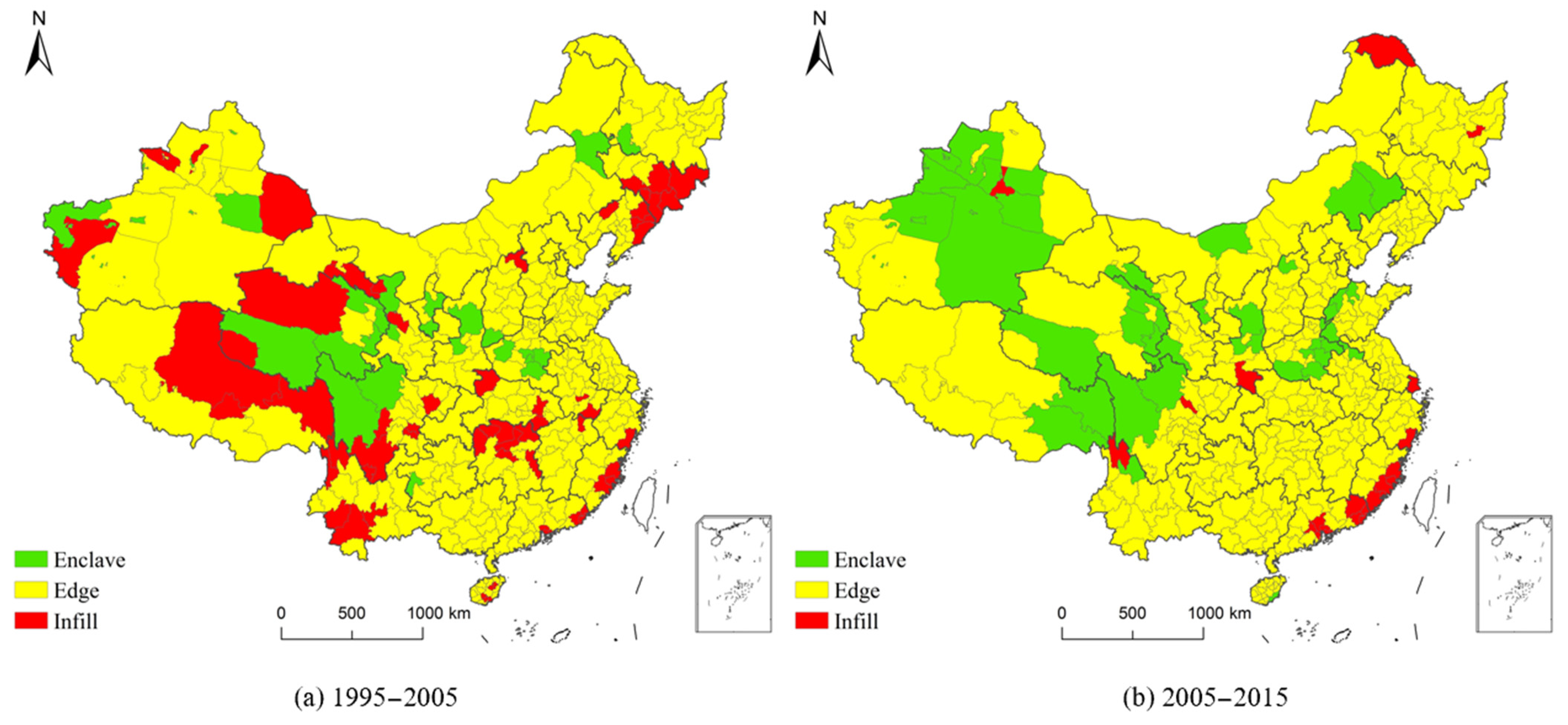
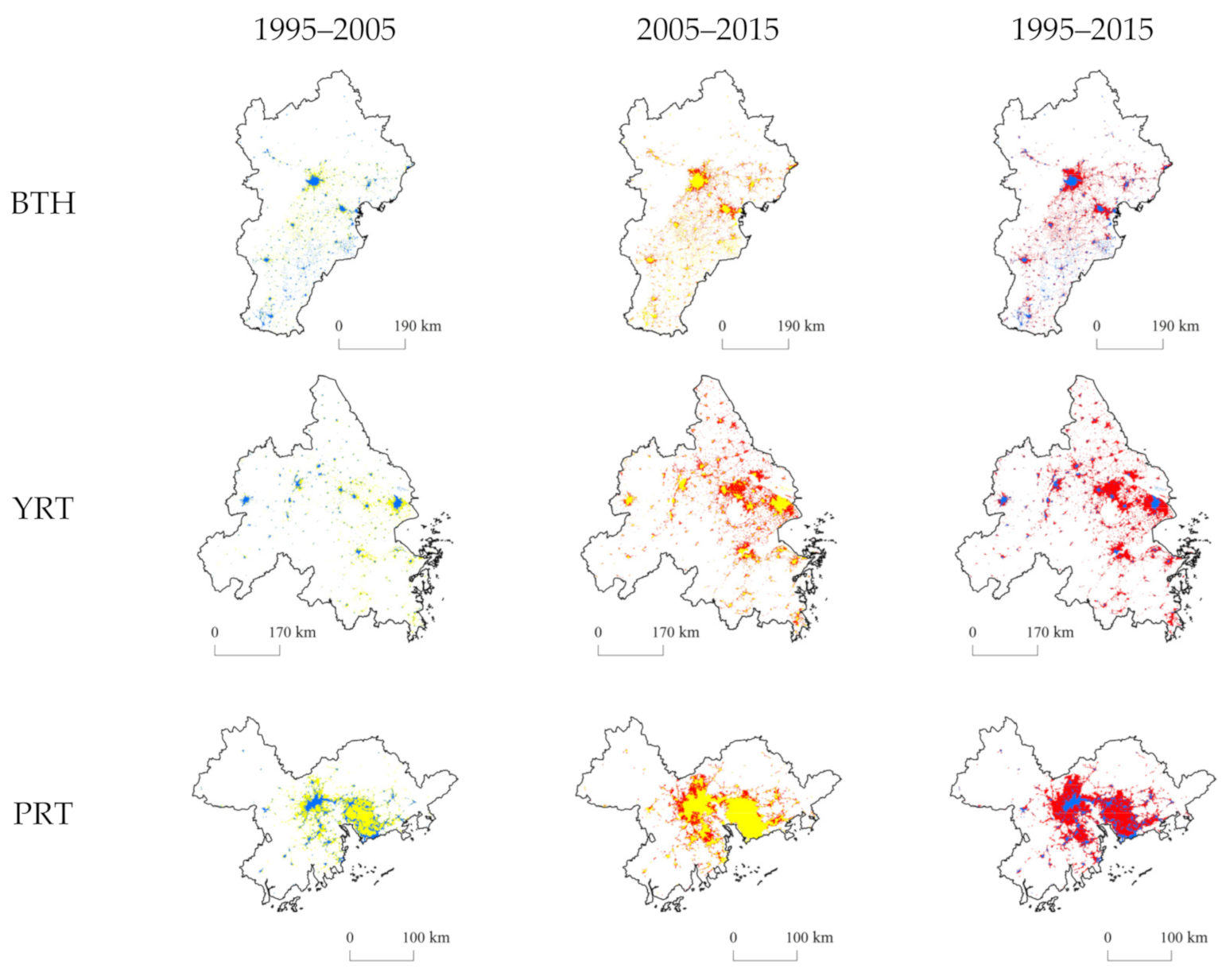
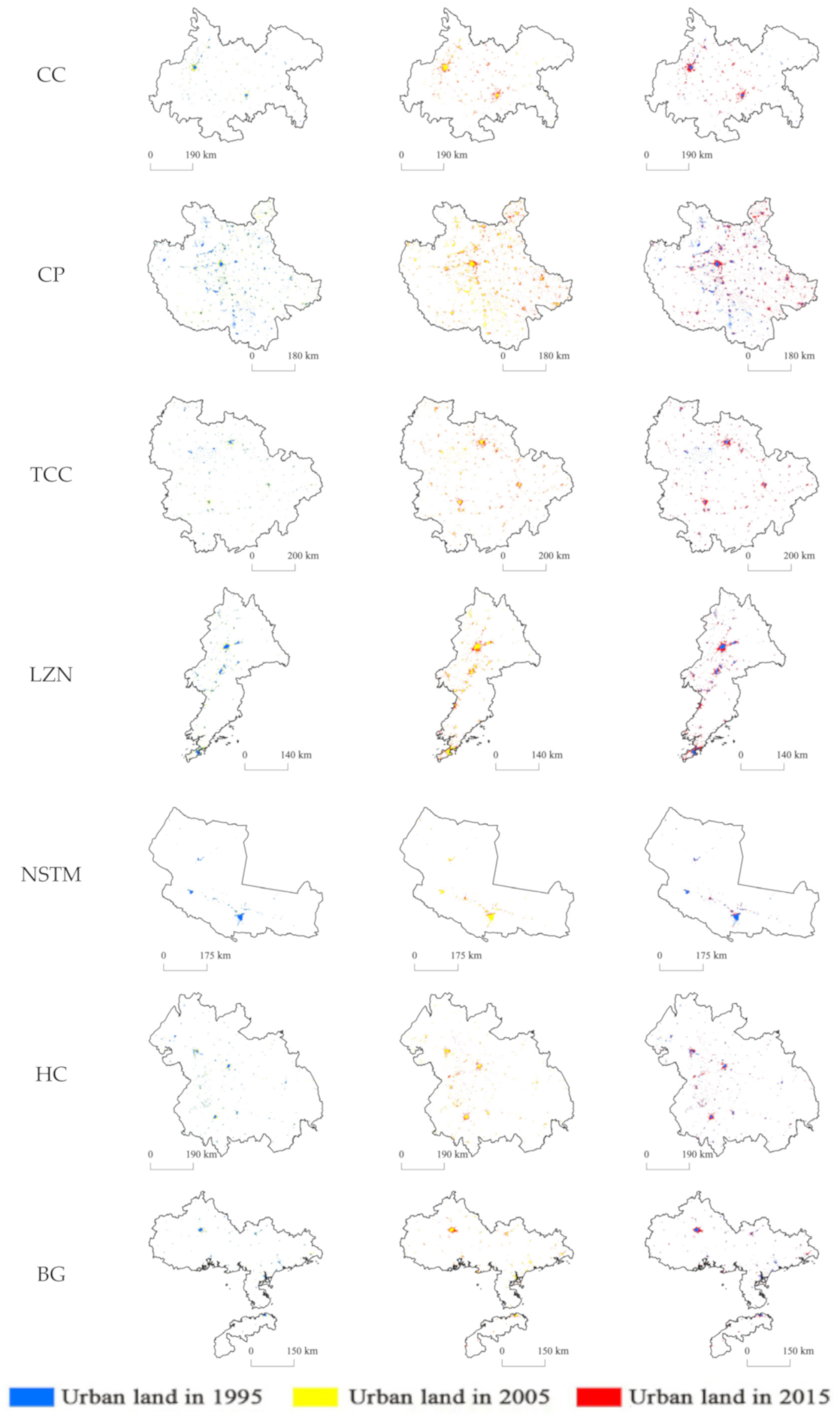
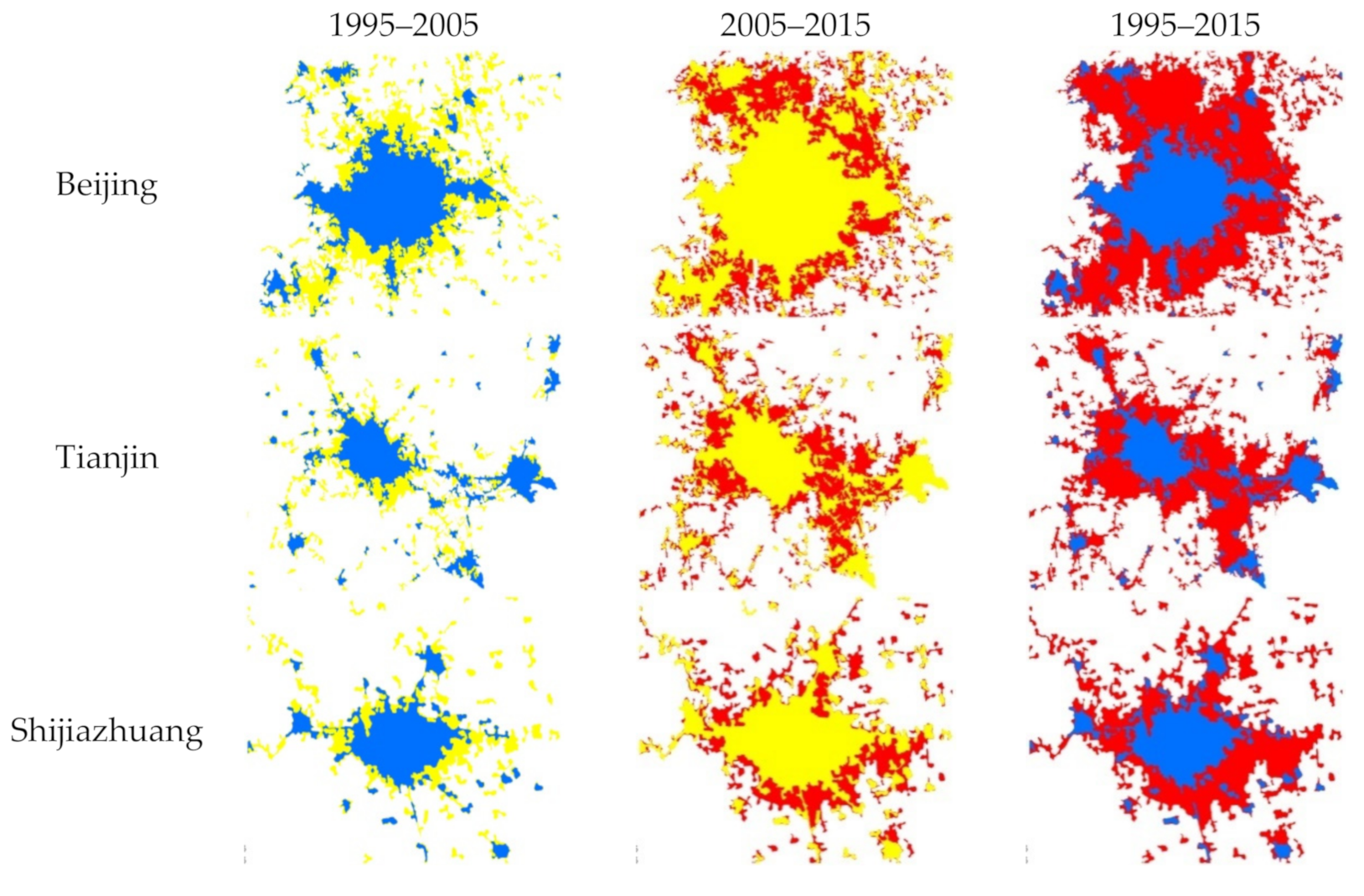
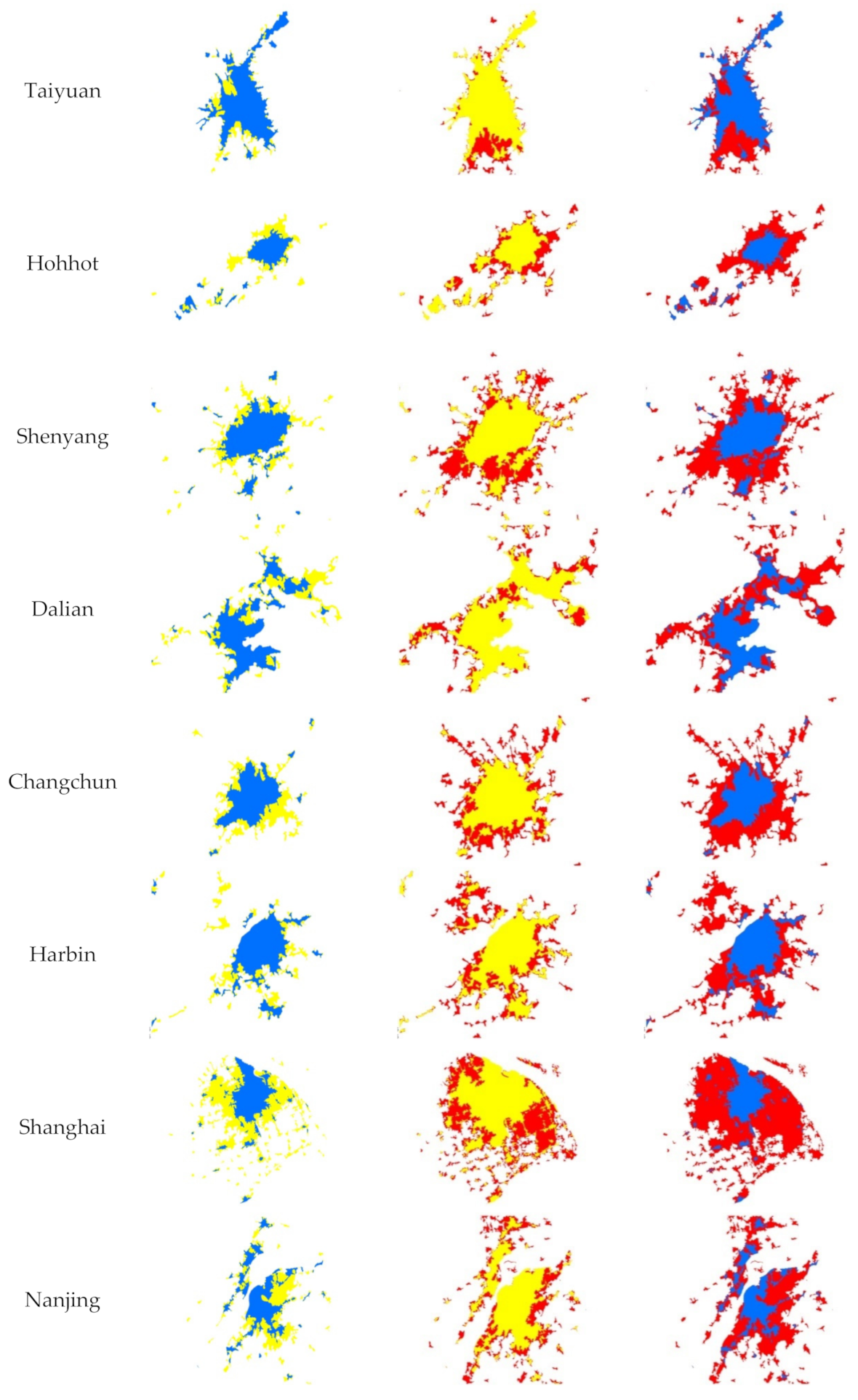
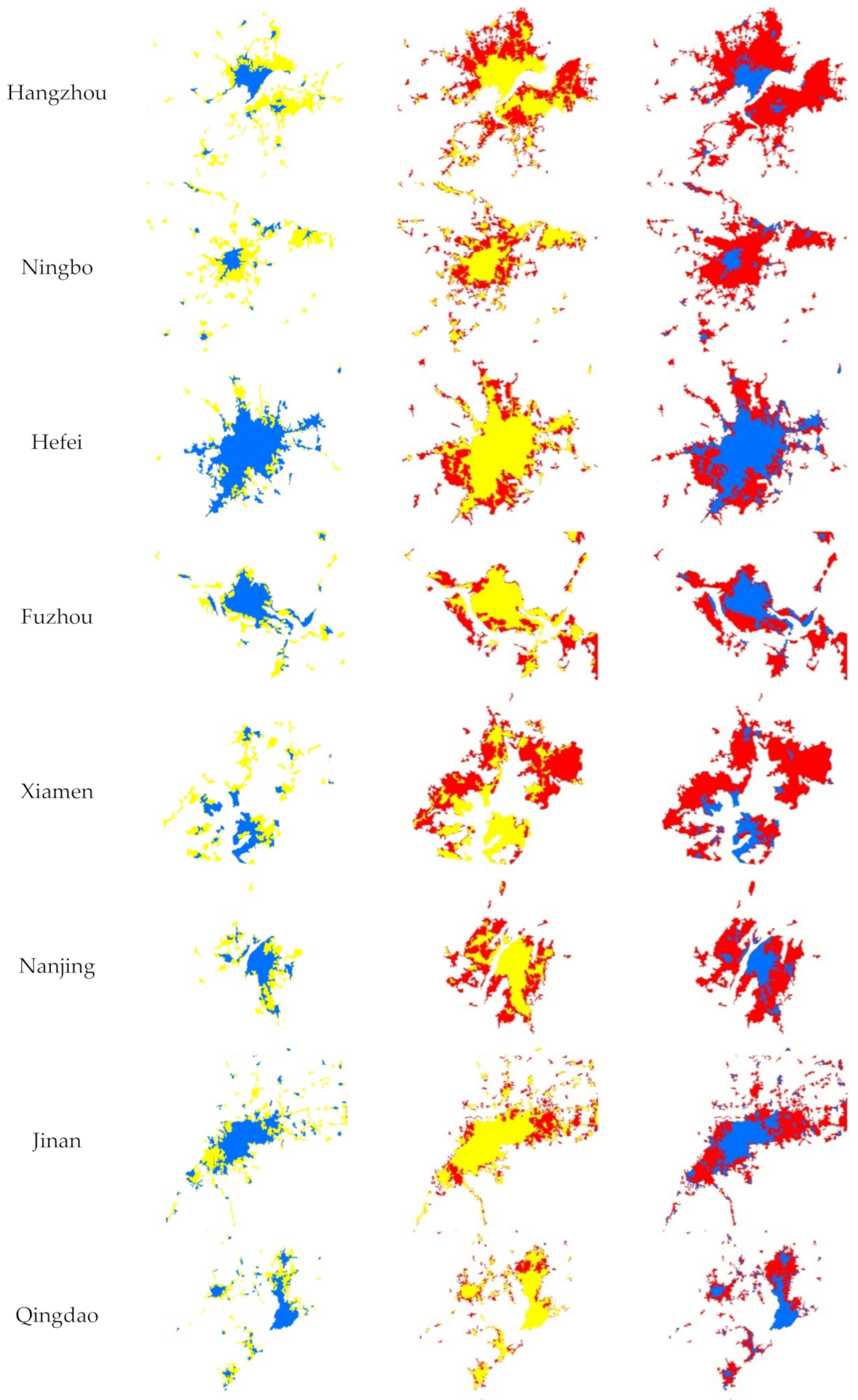
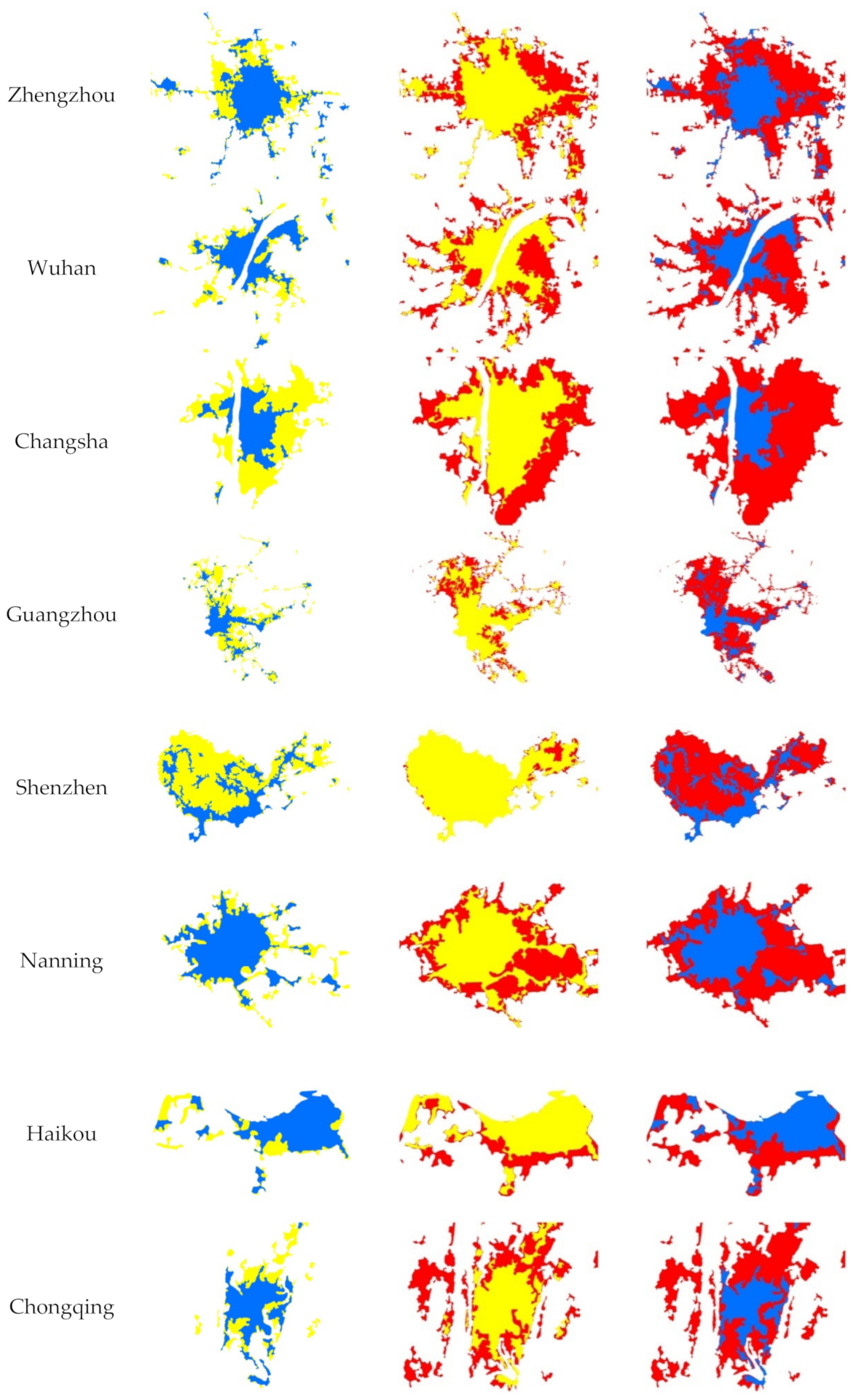


| Year | 1995 | 2000 | 2005 | 2010 | 2015 |
|---|---|---|---|---|---|
| Area (million km2) | 3.06 | 3.18 | 4.05 | 4.5 | 5.07 |
| Expansion area (million km2) | / | 0.12 | 0.87 | 0.45 | 0.57 |
| Rate of expansion (%) | / | 0.78 | 5.47 | 2.22 | 2.53 |
| Type of City | 1995 (%) | 2000 (%) | 2005 (%) | 2010 (%) | 2015 (%) |
|---|---|---|---|---|---|
| Megacity | 11.83 | 11.36 | 11.83 | 12.00 | 10.96 |
| Megalopolis | 9.44 | 8.76 | 10.60 | 10.89 | 10.42 |
| Large city | 11.23 | 12.17 | 12.48 | 12.26 | 12.74 |
| Total | 32.50 | 32.29 | 34.91 | 35.15 | 34.11 |
| Time Period | Arable Land (%) | Forests (%) | Grassland (%) | Water Areas (%) | Other Built Areas (%) | Unused Land (%) |
|---|---|---|---|---|---|---|
| 1995–2000 | 65.36 | 10.65 | 5.05 | 7.45 | 10.35 | 1.14 |
| 2000–2005 | 66.38 | 8.34 | 2.80 | 4.30 | 17.23 | 0.95 |
| 2005–2010 | 72.00 | 6.19 | 2.18 | 3.59 | 15.61 | 0.42 |
| 2010–2015 | 74.88 | 5.44 | 8.15 | 1.84 | 7.34 | 2.36 |
| 1995–2015 Overall | 67.98 | 9.15 | 5.10 | 5.36 | 11.07 | 1.33 |
| Infill Type Study Period | Enclave | Edge | Infill | |||
|---|---|---|---|---|---|---|
| Quantity | % | Quantity | % | Quantity | % | |
| 1995–2005 | 32 | 8.72 | 274 | 74.66 | 61 | 16.62 |
| 2005–2015 | 49 | 13.35 | 296 | 80.65 | 22 | 5.99 |
| Change | 17 | 4.63 | 22 | 5.99 | −39 | −10.63 |
| Name | 1995 | 2000 | 2005 | 2010 | 2015 | Expansion Area | Rate of Expansion | Intensity of Urban Expansion |
|---|---|---|---|---|---|---|---|---|
| BTH | 34.05 | 34.95 | 44.40 | 47.42 | 50.32 | 16.27 | 2.39% | 0.04% |
| YRD | 39.23 | 42.63 | 59.90 | 68.53 | 79.44 | 40.21 | 5.12% | 0.09% |
| PRD | 21.99 | 17.22 | 32.86 | 37.74 | 38.31 | 16.32 | 3.71% | 0.15% |
| CC | 8.98 | 11.00 | 14.11 | 17.37 | 18.78 | 9.80 | 5.46% | 0.02% |
| CP | 26.83 | 30.89 | 38.59 | 43.03 | 49.46 | 22.63 | 4.22% | 0.04% |
| TCC | 23.51 | 23.04 | 28.36 | 30.85 | 33.00 | 9.49 | 2.02% | 0.01% |
| LZN | 10.23 | 12.10 | 12.67 | 13.96 | 14.70 | 4.47 | 2.18% | 0.03% |
| NSTM | 4.80 | 5.84 | 6.31 | 6.43 | 9.61 | 4.81 | 5.01% | 0.01% |
| HC | 15.51 | 16.99 | 17.80 | 19.06 | 21.95 | 6.44 | 2.08% | 0.01% |
| BG | 8.20 | 7.71 | 9.05 | 9.61 | 10.29 | 2.09 | 1.28% | 0.01% |
Publisher’s Note: MDPI stays neutral with regard to jurisdictional claims in published maps and institutional affiliations. |
© 2021 by the authors. Licensee MDPI, Basel, Switzerland. This article is an open access article distributed under the terms and conditions of the Creative Commons Attribution (CC BY) license (https://creativecommons.org/licenses/by/4.0/).
Share and Cite
Cheng, C.; Yang, X.; Cai, H. Analysis of Spatial and Temporal Changes and Expansion Patterns in Mainland Chinese Urban Land between 1995 and 2015. Remote Sens. 2021, 13, 2090. https://doi.org/10.3390/rs13112090
Cheng C, Yang X, Cai H. Analysis of Spatial and Temporal Changes and Expansion Patterns in Mainland Chinese Urban Land between 1995 and 2015. Remote Sensing. 2021; 13(11):2090. https://doi.org/10.3390/rs13112090
Chicago/Turabian StyleCheng, Chuanzhou, Xiaohuan Yang, and Hongyan Cai. 2021. "Analysis of Spatial and Temporal Changes and Expansion Patterns in Mainland Chinese Urban Land between 1995 and 2015" Remote Sensing 13, no. 11: 2090. https://doi.org/10.3390/rs13112090
APA StyleCheng, C., Yang, X., & Cai, H. (2021). Analysis of Spatial and Temporal Changes and Expansion Patterns in Mainland Chinese Urban Land between 1995 and 2015. Remote Sensing, 13(11), 2090. https://doi.org/10.3390/rs13112090




